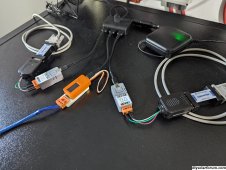dmkjr
Solar Enthusiast
Just wanted to share I found a cheap product to help with those that are getting power back from the micro-usb to the Solar Assistant. While it hasn't damaged the unit through the USB port it prohibits the unit from rebooting should it lose power for any reason. It's plugged into a circuit that is controlled by the inverter so when the unit switches modes from SBU (Solar/Battery/Utility) to SUB (Solar/Utility/Battery) -- no matter how quick the transition is -- the solar assistant PI4 will reboot. This piece of equipment has stopped the power feeding back, which allows the unit to reboot without issue.
Blocks power through the USB pins but allows data still. Reverse from the cables that are abundantly available that stops communications but allows power.
Blocks power through the USB pins but allows data still. Reverse from the cables that are abundantly available that stops communications but allows power.



